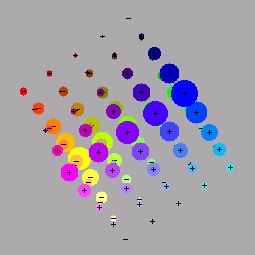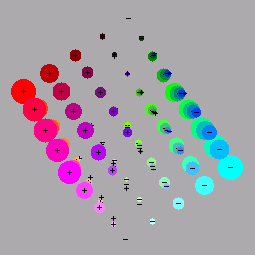The YCbCr color space
With the development of color TV, the engineers were presented with the challenge of superimposing color onto the existing image signal that was in Black & White. The way they achieved it was nothing short of amazing, and they used an approach which closely matches the physiology of the human eye. Behind the retina there is a layer of cells that processes the signals coming from retinal cells (RGB) and convert them to signals along the optic nerve, not as RGB but as three different signals: Brightness, Red/Green and Blue/Yellow. The TV engineers adopted this approach and developed the YCbCr color coding, where the brightmess was transmitted on the Y signal - exactly the same way as the then existing B&W signal was encoded, the Cb signal carried the Blue-Yellow strength and the Cr signal, the Red-Green signal.
I have explored this YCbCr "color space" and have modelled them in the images below, superimposing them on the RGB color space that I have explored above.
| The first model indicates the Y value (brightness) as the diameter of the balls. Obviously the white apex is the largest with the black apex the smallest. |
 |
| The second model represents the signal strength of the Cb channel, which represents the Blue end as positive values and the Yellow end as negative values. Again I have indicated the signal strength by the diameter of the balls, and have added + - to indicate positive and negative values. |  |
| The third model shows the Cr channel, with the red signals positive and the green signals negative. |  |
|
In this visualization, I have mapped the YCbCr color space in its own co-ordinate space. The cube has three axes: Y (brightness), with values ranging fro 0 to 255, Cb - Blue-Yellow, ranging from -179 to + 179 and Cr, Red-Green, ranging from -225 to + 225. These values have been set by international standards. As the Cb and Cr axes range from negative to positive values and the Y axis only from zero to positive, the Y axis intersects the cube at the centre of the base, not at an apex. For that reason, you will see that the white and black balls lie at the centre of the two base planes, not at the apexes as you would expect. The YCbCr color space is not a cube like the RGB space, but is shaped a bit like a brick that has been deformed in two directions , keeping the opposite surfaces parallel with each other, and then tilted on an apex. The long axis is the Y, or brightness axis, the mid-length axis is the Cb axis from Blue to Yellow and the short axis is the Cr axis, that ranges from Red to Green. |  |
|
Here is an animation of 100 "slices" through the YCrCb space I animated above, slicing across the Y (brightness) axis. Every slice shows the colors that are considered by the standards that control the matter, to have the same brightness.
The odd shapes are simply due to the fact that, as mentioned above, the color space is shaped like a deformed and tilted brick. |  |